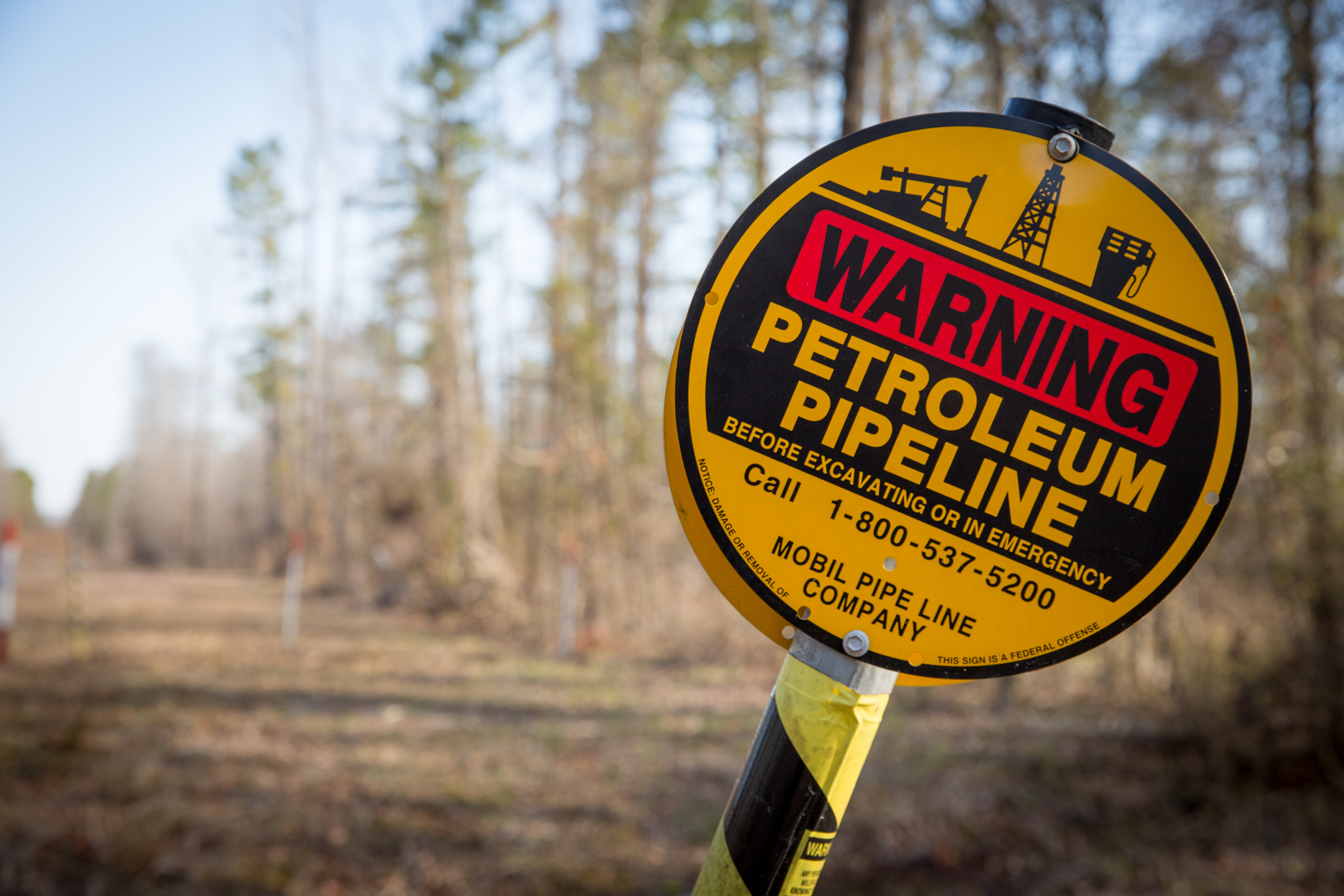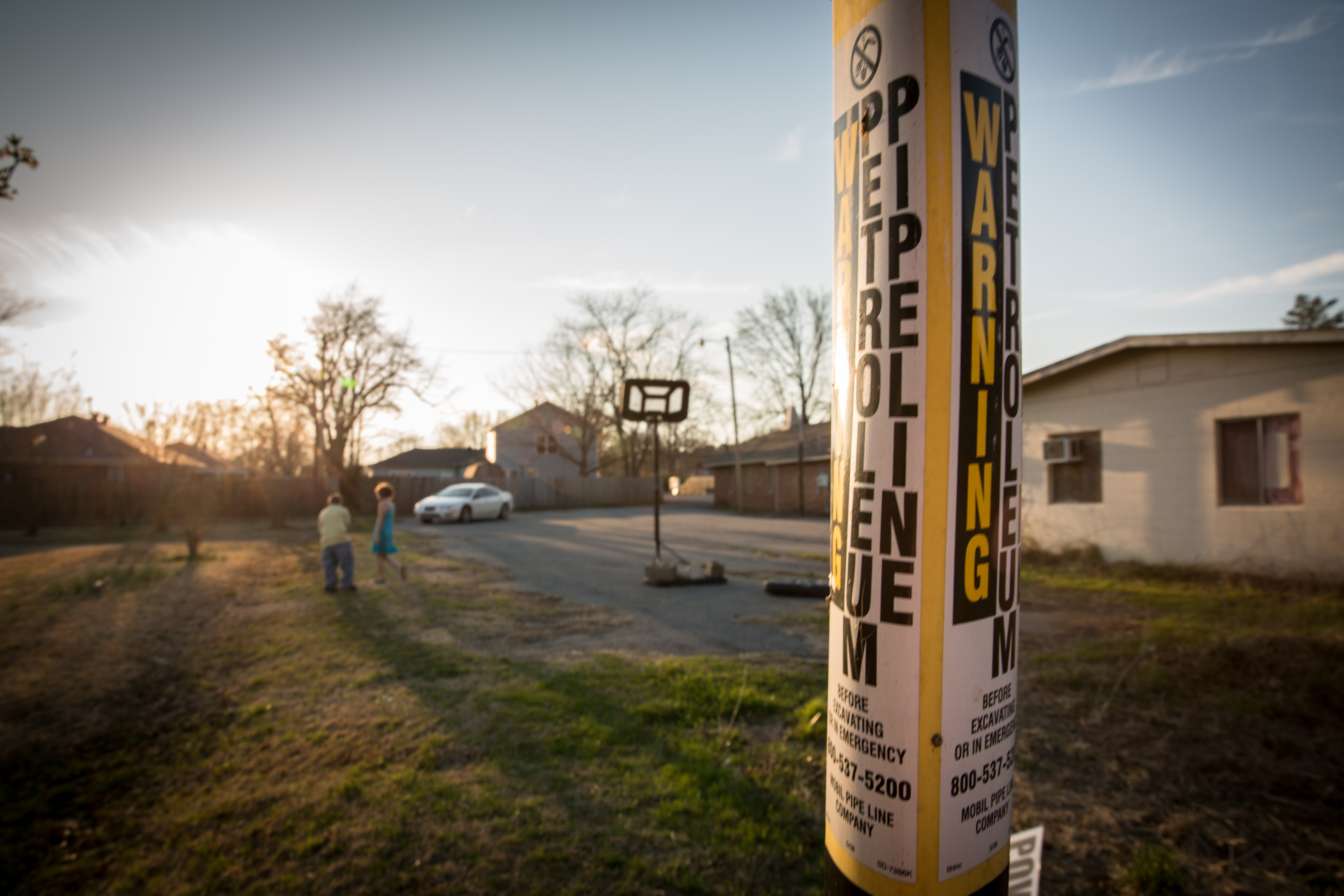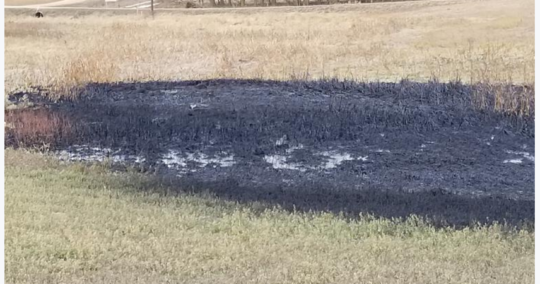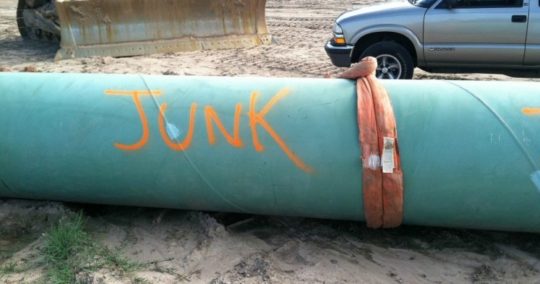

“I know everybody in Mayflower,” says Linda Lynch of her hometown in Arkansas. It seems almost possible. A bedroom community for Little Rock some 20 miles down I-40, Mayflower is a town of barely 1,600 with just one shopping center—a grocery store, a Dollar Store, and a Subway. In such a small town, Linda insists that she would have heard about an oil pipeline if any knew about it. But when she retired from her career as a paralegal and moved here from North Little Rock, no one cautioned that her daughter-in-law’s property on Snuggs Circle was a stone’s throw from an ExxonMobile right of way, much less that the company had reversed the flow of the 20-inch pipeline in April 2006, in order to carry tar sands crude from western Alberta to the refineries in Port Arthur, Texas.
So Linda had her trailer moved in and started volunteering at the food pantry across the road at the Mayflower Full Gospel Pentecostal Church of God, where her son and his family already attended church. Once a week, she met up with fellow congregants in the squat cinderblock building behind the church to pack food boxes and distribute to needy families. On Good Friday of last year, Linda planned to go to the fellowship hall to make corsages to give the children to wear on Easter Sunday. She called her daughter-in-law, Barbara, and caught her at the Dollar Store buying ribbons. Barbara told Linda she would meet her at the church about four o’clock.


But when Linda pulled up to the church about an hour later, she says she “smelled something,” something terrible in the air outside, and called Barbara back to ask about the odor. Barbara told her that the fumes had already permeated the shopping center and she had heard someone say a gas line had ruptured. But it didn’t smell like gas, Barbara said, and by now the parking lot outside the Dollar Store was crowded with emergency vehicles. She wasn’t sure how long it would take her to get home.
Linda went back to her trailer to let her dogs outside and wait for further news. The air now smelled of “sulfur and burnt tar,” she told me. When Linda’s daughter-in-law finally arrived home after an hour, she had no further information, only the sense, from passing through a police roadblock set up outside the Northwoods subdivision, that the rupture had occurred there. There was a lot to do to get ready for Easter Sunday, and the rupture, whatever it was, had already set them back, so they went together to the fellowship hall. Just before six o’clock, Linda decided to run home to watch the news to see if the police ever determined the source of the smell. When she opened the door, she remembered, “it almost knocked me down. It gagged me . . . I couldn’t breathe.”
Linda called her son, Scott, who told her that he had his camera and was heading through the woods to the Northwoods subdivision, just over the hill from the church, to find out what was going on. His photos of the rupture were later picked up by the local news and circulated again and again on the web. There are images of thick black heavy crude flowing around the foundation of a house, encompassing the tiny playset in the backyard. The oil cascades down one driveway and flows down the street to a rainwater drainage ditch. Emergency vehicles and American Red Cross vans are parked along nearby streets. Neighbors stand with police officers looking on in shock, covering their mouths.
Afterward, Scott returned home, and everyone waited anxiously to be told if they should evacuate. But no one came to warn Linda, her family, or her neighbors that ExxonMobile’s Pegasus pipeline wasn’t carrying conventional crude oil but a type of tar sands crude classified as “Wabasca heavy.” No one told them that the material safety data sheet (MSDS) already being distributed to emergency workers indicated that the Wabasca heavy was diluted by a host of toxic chemicals and that the rupture had filled the air with dangerous levels of benzene, possibly harmful levels of octane, cyclohexane, heptane, and hexane, and detectible levels of toluene, butane, and pentane. Linda and her family waited all night for more news. When we talked a year later outside the church pantry, Linda shook her head angrily. “No one ever came,” she told me, “not a soul.”
***
It rained all through the night. Linda left the windows open in her tiny trailer, hoping to air out the chemical smell. It was something she did often, she told me, “because I like that fresh air.” But when Linda awoke, she found her trailer consumed by fumes. Outside, the odor was even stronger. What Linda didn’t know at the time was that, although the pumping stations had been shut down on the Pegasus pipeline soon after the spill was reported, some 250,000 gallons of tar sands crude had already flowed through the Northwoods subdivision into the drainage ditch, followed across North Main Street into another ditch, then through a culvert under the railroad tracks into a larger drainage ditch, past the shopping center, through a culvert that passes under Interstate 40, and finally into Dawson Cove on Lake Conway. The whole town, on both sides of the highway and as much as three miles from the spill site, was under a chemical cloud.
Local first responders had evacuated part of the Northwoods neighborhood but only those homes where they could see oil on the property. When public health advocate April Lane, a student at the University of Central Arkansas in nearby Conway, arrived on the scene, she found Northwoods residents lined up along the roadway, watching as cleanup workers hosed down North Starlite Road, washing the oil into the sewage system. The air was choking with toxic chemicals. Some people were bent over from nausea, and Lane herself had to fight her natural gag reflex. Instinct told her this wasn’t a safe place to be. She started going door-to-door, telling people to evacuate, that they were risking their health if they remained there. But Lane didn’t know about Snuggs Circle on the other side of the ridge. So Linda and her family and all of her neighbors stayed put, awaiting word.
On Saturday afternoon, they learned that ExxonMobil would be holding an informational town hall meeting at the local high school. Linda sat in the front row, eagerly hoping to get answers to her worries, but she said that it quickly became clear that the purpose of the meeting was not to keep residents informed but to make them feel as if they were overreacting. “They made us feel like we were just stupid,” Linda said. She asked Exxon officials several direct questions but “never got a straight answer,” so finally she stated her concern as bluntly as she knew how. “I live on Snuggs Circle directly, right behind the rupture, 200 yards from it,” she said. “Are we in any danger over there, of these fumes?’” She said she was told that there was no danger and to contact poison control in Little Rock if she had further concerns. A year later, Linda still couldn’t believe the treatment residents received. “I asked five questions,” she said. “All I heard was bullcrap.”
At the end of the meeting, Exxon informed attendees that they had brought them Easter baskets. They were invited to take one with them as they left. Linda said she regarded the baskets as an insult. When she left the church, she said, she didn’t see a single person take one.
***
Exxon has done it’s very best to erase all visible signs that the spill ever occurred—tearing down the three most-contaminated homes, repaving North Starlite, power-washing the drainage ditch, and dredging and landscaping over oil-soaked yards. The company has been busily preparing these homes to go back on the market, assuring prospective buyers that they are perfectly safe to live in and that the property has retained all of its former value, and telling the Pipeline and Hazardous Material Safety Administration (PHMSA) that the clean neighborhood is proof that Exxon should be allowed to restart Pegasus.
But PHMSA has raised serious concerns. In their original Corrective Action Order, the agency noted that the pipeline was built in 1947 and 1948 to carry light grade crude oil from the Texas Gulf Coast to Patoka, Illinois, about 75 miles east of St. Louis. “In 2006, [the ExxonMobil Pipeline Company] reversed the system flow on the Pegasus Pipeline. The pipeline now flows from Illinois to Texas. A change in direction of flow can affect the stress demands on the pipeline.” The order also recommended that the pipe should not be operated at more than 656 pounds per square inch of gauge; it was operating at 708 psig at the time of the rupture. Environmental advocates argue that the elevated pressure in the line was the result of pumping heavy-grade diluted bitumen, instead of the light-grade it was built to transport.
ExxonMobil, however, disputes the very classification of their crude. Just days after the spill, the company posted a list on their website of “Five Lies They’re Telling You about the Mayflower Pipeline Spill.” First among them was the claim “that oil spilled in Mayflower is diluted bitumen from the Canadian oil sands.” While the company conceded that the oil derived “from Alberta near the area where there is oil sands production” and that it had been “diluted by a light oil to help it flow through the pipeline,” it disputed the claim that this was diluted bitumen. The Pegasus was carrying Wabasca Heavy, the post explained, “produced by conventional production methods—in other words by drilling a well into the ground through which the oil flows.” That same day, the Environmental Protection Agency sent an e-mail to Richard Byrne, Exxon’s assistant chief attorney of environmental and safety law, seeking clarification: “Can the oil accurately be described as oil sands oil, or a type of diluted bitumen (dilbit)?” Byrne responded, “Canadian producers report their production of Wabasca Heavy as bitumen”—but the post calling that classification a lie remains on the website nearly a year later.
Residents of Mayflower say this was just the first of many cases of doubletalk from Exxon representatives. People like Linda, who live close enough to the spill site to have been affected by the fumes—but not close enough to qualify for ExxonMobil’s Home Purchase Plan—say they are trapped. They can’t find buyers for their houses. They don’t dare walk away from their mortgages or their land. And they can’t afford to simply move out and pay on two homes. Many have chosen to sue, hoping to force the company to pay out enough that they can escape the path of the spill, but while their cases make their way through court, they wait and wonder what lingering effects the spill may be having on them.
“My health has been so bad this past year,” Linda told me. “This has been the worst year of my entire life—constant coughing, blurred vision, stomach cramps, and these horrible headaches, and ears ringing.” But it wasn’t her health that she was worried about most. Since the spill, her son’s testicular cancer has returned, after more than two years in remission. Was it the chemicals, the exposure he received while shooting video of the Northwoods neighborhood that brought it back? And what about her grandchildren and great-grandchildren? She worried about all of the neighborhood kids who play in the field behind the church, just a few feet from the path of the pipeline.


In fact, that evening as the sun set over Snuggs Circle, I found two children, a brother and sister ages 10 and 11, laughing and yelling as they chased each other around a basketball hoop in the parking lot of the church. I asked if they remembered the day of the spill, and they turned suddenly somber. “Yeah,” the boy said, “it was real bad.” Had anyone done anything to make things safer for them, I wondered. He pointed to a new sign posted in the middle of the field and already tipped at an angle: WARNING: PETROLEUM PIPELINE.



